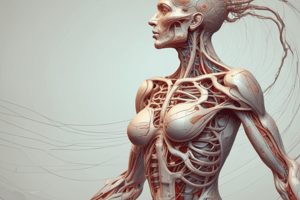Podcast
Questions and Answers
Angular motion is comprising of flexion, extension, ______ and ______.
Angular motion is comprising of flexion, extension, ______ and ______.
adduction
______ is making circular movement.
______ is making circular movement.
Circumduction
______ is the movement of the ankle while elevating the sole as if digging in the heel.
______ is the movement of the ankle while elevating the sole as if digging in the heel.
Dorsiflexion
______ is the opposite movement of dorsiflexion, it extends the ankle and elevating the heel.
______ is the opposite movement of dorsiflexion, it extends the ankle and elevating the heel.
______ is a movement wherein it moves a part of the body anteriorly in the horizontal plane.
______ is a movement wherein it moves a part of the body anteriorly in the horizontal plane.
______ is a movement which turns the body or a limb around the longitudinal axis.
______ is a movement which turns the body or a limb around the longitudinal axis.
Abduction is a movement away from the ______
Abduction is a movement away from the ______
Adduction is a movement toward the ______ of the body
Adduction is a movement toward the ______ of the body
Angular motion involves rotation around a ______
Angular motion involves rotation around a ______
Plantar flexion is the movement where the foot points ______
Plantar flexion is the movement where the foot points ______
Circumduction is a circular movement that combines ______ and abduction
Circumduction is a circular movement that combines ______ and abduction
During circumduction, the limb moves in a cone-shaped pattern involving flexion, extension, abduction, and ______
During circumduction, the limb moves in a cone-shaped pattern involving flexion, extension, abduction, and ______
The movement on pushing and pulling will provide muscles and joint receptors information about the position of body parts (leg, arms, head, and ______) in space.
The movement on pushing and pulling will provide muscles and joint receptors information about the position of body parts (leg, arms, head, and ______) in space.
Obstacle activities performed in different positions (supine, prone, ______).
Obstacle activities performed in different positions (supine, prone, ______).
Doing house chores like car washing, vacuuming, cleaning, ______ will give proprioceptive feedback.
Doing house chores like car washing, vacuuming, cleaning, ______ will give proprioceptive feedback.
Moving solo, solo within a group and moving about a ______.
Moving solo, solo within a group and moving about a ______.
Balloon ______ is an exercise to improve neuromuscular coordination.
Balloon ______ is an exercise to improve neuromuscular coordination.
______ is the ability to develop a conscious recognition of one's body movements while performing various physical activities.
______ is the ability to develop a conscious recognition of one's body movements while performing various physical activities.
Flashcards are hidden until you start studying
Study Notes
Movement Education
- Movement education is the backbone of Physical Education, helping improve motor skills through physical movement and increasing efficiency in performing daily activities.
Fundamental Skills
- Running: a walk with longer strides and a push-off by the foot to suspend the body momentarily in air.
- Balancing: a state of equilibrium or in a steady position.
- Catching: grabbing or holding a thrown object.
- Hopping: jumping with one foot and landing on the same foot.
- Throwing: projecting or propelling from the hand by a sudden forward motion or straightening of the arm and wrist.
- Galloping: a front foot steps forward with a little spring followed by the transfer of body weight to the back foot.
- Leaping: springing from one foot and landing on the other foot.
- Skipping: moving in a spring manner with a bounce alternate hop on each foot.
- Kicking: striking using the foot or the feet.
- Jumping: leaping or springing from the ground.
Categories of Fundamental Skills
- Stability Skills: body movements done in place, while moving around in horizontal and vertical axes.
- Locomotor Skills: movements include running, jumping, galloping, and hopping.
- Manipulative Skills: skills such as throwing, kicking, catching, and striking.
Types of Movement
- Abduction: movement away from the center.
- Adduction: movement toward the midline of the body.
- Angular Motion: comprising of flexion, extension, adduction, and abduction.
- Circumduction: making circular movement.
- Dorsiflexion: movement of the ankle while elevating the sole as if digging in the heel.
- Plantar Flexion: opposite movement of dorsiflexion, extending the ankle and elevating the heel.
- Elevation/Depression: structure moves in a superior or inferior direction.
- Extension: reverse of movement of flexion.
- Flexion: movement in the anterior-posterior plane that reduces the angle between the articulating elements, performed by flexing.
- Gliding: occurs when two opposing surfaces slide past each other.
- Opposition: movement of the thumb which enables it to grasp and hold an object.
- Pronation/Supination: rotation moves the wrist and hand from palm-facing-front (supination) to palm-facing-back (pronation).
- Protraction: movement wherein it moves a part of the body anteriorly in the horizontal plane.
- Retraction: reverse movement of protraction.
- Rotation: movement which turns the body or a limb around the longitudinal axis.
Effort Awareness
- Ability to develop a conscious recognition of one's body movements while performing various physical activities.
- 3 components: Time, Control, and Force.
- Relationships: moving solo, solo within a group, and moving about a group.
Heavy Work Activities
- Provide muscles and joint receptors information about the position of body parts in space and relationship with other objects.
Obstacle Activities
- Performed in different positions (supine, prone, kneeling).
Home Chores
- Provide proprioceptive feedback through activities such as car washing, vacuuming, cleaning, and mopping.
Exercises to Improve Neuromuscular Coordination
- Balloon Tossing
- Juggling
- Small Ball Tossing
- Jump Rope Drills
- Target Practice
- Ball Toss from Different Positions
- Balloon Hockey
- Dribbling BPED
Studying That Suits You
Use AI to generate personalized quizzes and flashcards to suit your learning preferences.




